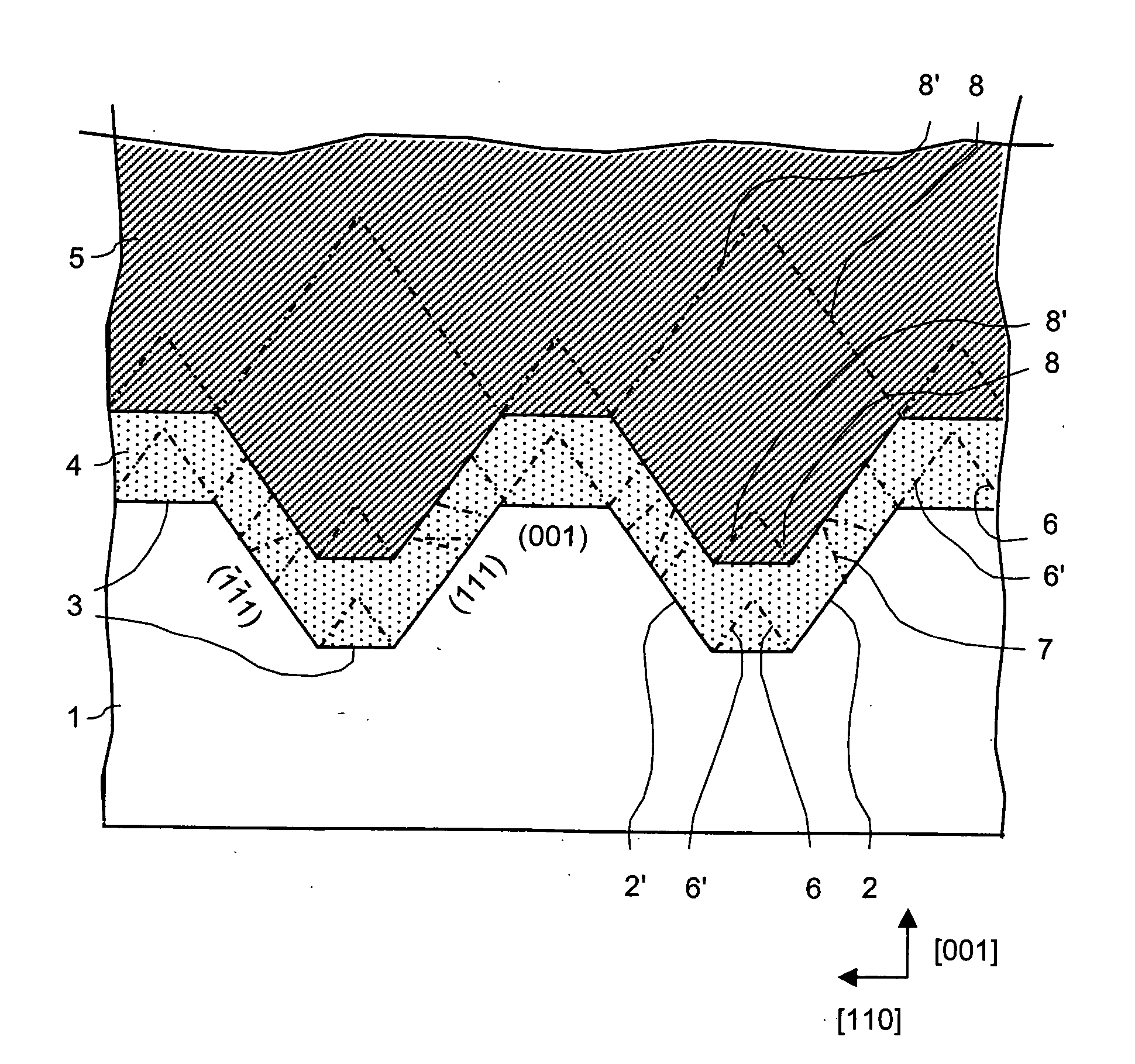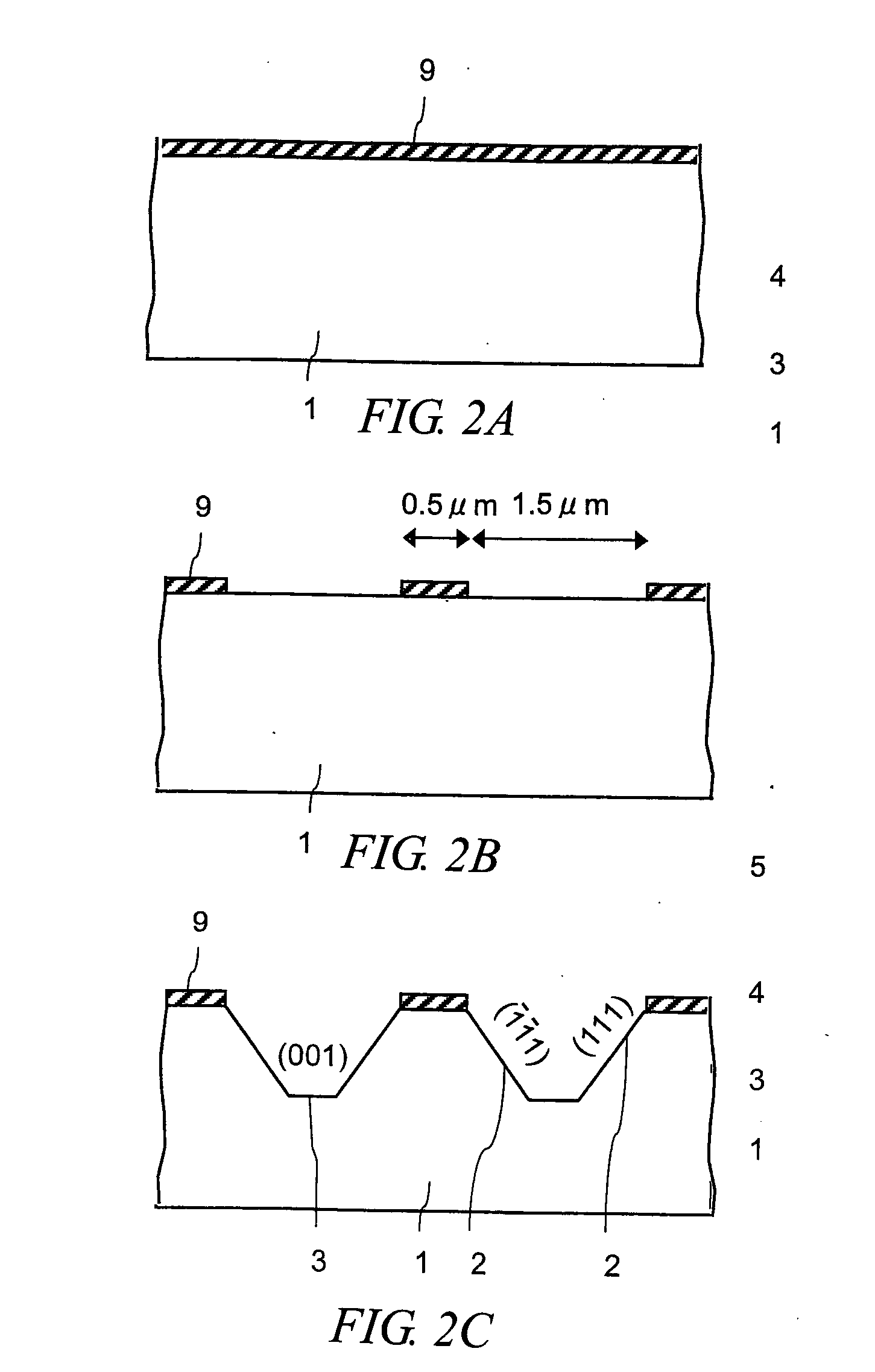Semiconductor device and manufacturing method thereof
a technology of semiconductors and thin films, applied in semiconductor lasers, solid-state devices, lasers, etc., can solve the problems of deteriorating device operation, heterogeneous materials, and high cost of materials for bulk substrates, and achieve the effect of sharp reduction of defect density and high quality
- Summary
- Abstract
- Description
- Claims
- Application Information
AI Technical Summary
Benefits of technology
Problems solved by technology
Method used
Image
Examples
first embodiment
[0050] Embodiments on a semiconductor device and the production method therefor related to the present invention are described in further detail with reference to accompanying drawings.
[0051]FIG. 1 a cross sectional view of a first embodiment of a semiconductor thin film related to the present invention. On a single crystal silicon (Si) substrate 1 are formed a plurality of pair of facets 2 and 2′ arranged in line. A threading dislocation density at the substrate surface where the facets are formed is less than 1 / cm2. At this point, the opposing facets 2 and 2′ have a form being mirror-symmetrical to an axis perpendicular to the substrate, i.e., to the surface orientation of the substrate. On the bottom of the grooves formed by the facets themselves and between the adjacent grooves lie flat portions 3. The flat portions do not always need to exist when the facets are formed, but it is preferable to form them in advance as shown in FIG. 1. An example without the flat portions is des...
second embodiment
[0057] The first embodiment describes spontaneous production of defects at an angle portion in forming SiC layer 5. Depending on growth conditions of SiC layer 5 and crystallinity of the buffer layer 4, it may be stable in energy to propagate defects in layer 4 into SiC layer 5 directly. In this situation, defects at angles are not produced in SiC layer 5, a large number of defects produced in the buffer layer 4 will propagate directly into the SiC layer 5. FIG. 7 is a cross sectional view of a semiconductor thin film showing a second embodiment related to the present invention in view of the above description. Here, the same reference characters as in the first embodiment are used, only differences from the first embodiment are extracted to describe. This embodiment is characterized in that the growth rate of (001) and (111) planes is regulated when the buffer layer 4 is grown so that defects 6 and 6′ can be always positioned at angles on the bottom of the groove on the surface of ...
third embodiment
[0058]FIG. 8 is a cross sectional view of a semiconductor thin film shown in a third embodiment related to the present invention. Description will be made also using the same reference characters as in the first embodiment. In the present embodiment double SiGeC layers 4a and 4b different from each other in Ge composition are used as semiconductor buffer layer 4. Layer 4a right on substrate 1 is characterized by containing more Ge than layer 4b in composition. It is supposed that both the first and the second SiGeC layer 4a and 4b share defects 6a and 6a′ and 6b and 6b′ produced from angles made by facets and flat portions. Even in the present embodiment, the first SiGeC layer with more Ge—C bonds acts as a buffer for the second SiGeC layer, and the second layer also acts as a buffer for SiC layer 5. This can gradually decrease defects, which will be effective if decrease in defect is not sufficient in the first buffer. In the present embodiment, double SiGeC buffer layers 4 are tak...
PUM
| Property | Measurement | Unit |
|---|---|---|
| temperatures | aaaaa | aaaaa |
| thickness | aaaaa | aaaaa |
| width | aaaaa | aaaaa |
Abstract
Description
Claims
Application Information
 Login to View More
Login to View More - R&D
- Intellectual Property
- Life Sciences
- Materials
- Tech Scout
- Unparalleled Data Quality
- Higher Quality Content
- 60% Fewer Hallucinations
Browse by: Latest US Patents, China's latest patents, Technical Efficacy Thesaurus, Application Domain, Technology Topic, Popular Technical Reports.
© 2025 PatSnap. All rights reserved.Legal|Privacy policy|Modern Slavery Act Transparency Statement|Sitemap|About US| Contact US: help@patsnap.com



